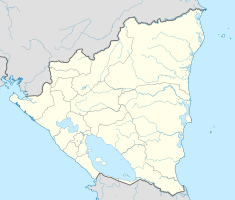Poneloya
| Poneloya | ||
|---|---|---|
|
Coordinates: 12 ° 22 ′ N , 87 ° 2 ′ W Poneloya on the map of Nicaragua
|
||
| Basic data | ||
| Country |
|
|
| Department | Leon | |
| Detailed data | ||
| Time zone | UTC −6 | |
Poneloya is a village on the Pacific coast of Nicaragua in the department of León .
location
It is located at an estuary 20 km west of León and 110 km north of Managua, the country's capital. The bird island "Los Brasiles" is nearby . Poneloya is located on the ring of fire in Central America, so in the distance you can see volcanoes soaring into the sky. Every now and then you can feel smaller earthquakes. The name "Poneloya" means something like "small seed" in the indigenous language of the Sutiava tribe .
history
Its location at an estuary suggests that the place initially developed as a fishing village. Even today, a large part of the local population lives from fishing. Over time, the affluent urban population of León built their weekend houses along the local coast of Poneloya.
On September 1, 1992, there was a magnitude 7 seaquake 75 km from the coast. The entire Nicaraguan coast was hit by a tsunami up to 10 meters high. The waves that reached Poneloya at 6 a.m. and 7 p.m. (the clocks were switched to winter time on that day) were up to 6 meters high and destroyed a large part of the houses and claimed at least four lives in Poneloya alone (the information vary). Many houses were rebuilt after the disaster, but some are still in ruins. In 1998, Hurricane Mitch struck and caused considerable damage. In 2008 Poneloya was hit by another hurricane, this time a Category 1, with little damage.
In early 2010, a new road from León to Poneloya for $ 16.5 million was completed with funding from the US Millennium Project. In addition, several foreign fish farms have set up shop in the immediate vicinity.
tourism
The majority of Nicaraguan visitors come from León at the weekend to either spend the day at the beach or to visit their holiday homes. There are some relatively inexpensive restaurants and hotels. The main season is around the "Semana Santa" (Easter), in the transition week between March and April and Christmas, when the children have summer vacation. There are good surfing conditions on the beach. Local guides offer tours to the island of “Los Brasiles”, an almost self-contained ecosystem, to observe the diversity of birds. The place is still mostly unknown to foreign travelers.
Economic development
Poneloya is characterized by strong contrasts (magnificent villas opposite huts made of corrugated iron). Most of the residents earn their living either as fishermen or as housekeepers of the weekend villas. Some have a small eatery or a “pulperia”, a small kiosk that sells all everyday consumer goods from toothpaste to toilet paper. The work in the fish farms guarantees a secure income. There are also a few pharmacies, a police station located exactly between Poneloya and Las Peñitas, a secondary school, a health center and several churches.
Climate and fauna
As Poneloya is located in the subtropics, the place is characterized by a dry and a rainy season . The rainy season, which Nicaraguans also refer to as "winter time", although temperatures remain relatively constant throughout the year, begins in June and ends in December or January. Logically, the dry season starts at the beginning of the year and ends at the end of May / beginning of June. Temperatures range from 32 ° C to 40 ° C (90 ° F to 104 ° C) during the day and from 25 ° C to 30 ° C (77 ° F to 86 ° F) at night. The fauna on the coast is characterized by mangrove swamps and inland by tropical dry forests and grasslands or savannas .
Web links
Individual evidence
- ↑ Lonely Planet, Lucas Vidgen, Adam Skolnick: Lonely Planet Nicaragua (= Travel Guide ). 2nd Edition. Lonely Planet Publications, Footscray 2010, ISBN 978-1-74220-365-2 , pp. 184 (English, limited preview in Google Book Search).
- ↑ http://www.nicatour.net/en/nicaragua/poneloya.cfm
- ↑ http://www.fallingrain.com/world/NU/08/Poneloya.html
